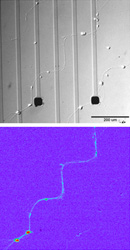Implantable Retinas Come Alive
The use of implanted retina chips to restore vision is still some way off. But scientists have taken a significant step toward that goal by finding a way to trigger the firing of individual retinal cells, by growing them on a silicon-based eye implant. The research represents a key step in making artificial vision considerably better and more natural than current methods used for prosthetic retinas.

One of the biggest challenges in developing artificial retinas has been finding a way to stimulate cells in the eye to fire individually rather than en masse. Now, by getting the retinal ganglion nerve cells to grow and plug themselves into a silicon device, it is possible, says Stacey Bent, a chemical engineer at Stanford University, whose research appears in the current issue of Biomedical Microdevices.
There are several different approaches used today in the attempt to develop retinal prosthetics. But the basic principle underlying all of them is the same: by stimulating cells within the retina, vision sensations can be elicited in the visual cortex. This is possible because for some common eye diseases, like retinitis pigmentosa and macular degeneration, only the light-sensitive photoreceptor cells in the retina are damaged. This means other types of cells in the retina and visual cortex in the brain remain intact and fully functional.
Until now, the method of choice for repairing these cells has consisted of using arrays of electrodes placed near the retina to stimulate the cells electrically. The trouble with this technique is that, apart from the electrodes being larger than the cells they’re trying to stimulate, there is no way to isolate the electric fields in order to trigger individual neurons without triggering their neighbors.
Encouraging the cells to grow tentacle-like dendrites between the cell and an electrode, the strategy used by Bent, gets around this problem by creating a communication channel that stimulates the cell without invading or disrupting the structure of the retina.
The real payoff with this method, though, is the ability to make use of the preprocessing of the retina, says Bent. Until now, most research has focused on stimulating the retinal ganglion cells, the large cells that feed signals directly into the optic nerve. But this bypasses all the motion-detection and edge-detection processing carried out in the retina itself by a network of neurons called bipolar cells.
The ability to stimulate individual cells opens the door to the possibility of stimulating bipolar cells instead of ganglion cells, says Bent. “We’d be taking advantage of the existing circuitry,” she says.
Working with Harvey Fishman and other colleagues from Stanford University, Bent prepared a patterned array of electrodes with a neuron growth-promoting protein called laminin, then seeded it with retinal ganglion cells from rats. After 48 hours, tentacle-like growths from the cells were found to have followed the patterns of the laminin.
The group then applied signals to these electrodes, to show that the cells could be stimulated at power levels an order of magnitude less than previously required. That’s important because in a device it reduces the chance of a signal leaking out and affecting neighboring cells, says Bent.
Not everyone is convinced that such controlled and directed growth of bipolar cells will be possible in a live implant, however. While the idea of using dendrite growth is a good way to bridge the gap between electrode and neuron, Peter Fromherz, head of the Department of Membrane and Neurophysics at the Max Planck Institute for Biochemistry in Germany, believes the complex patterns needed to keep the electrodes separate would quickly get swamped.
Furthermore, there’d be the issue of keeping the cells alive under such conditions, says Eberhart Zrenner, director of the Department for Pathophysiology of Vision and Neuro-Ophthalmology at the University Eye Hospital of Tübingen, in Germany. “They need a proper oxygen supply,” he says, as well as nutrients.
Now Bent’s group wants to apply this approach to stimulate cells using chemicals instead of electricity. This would involve using microfluidic channels instead of electrodes to squirt neurotransmitter chemicals at nerves or their dendrites to trigger them. Several research groups are now turning to this approach because it’s a natural progression, says Bent. “It is one step closer to what happens in nature,” she explains.
Keep Reading
Most Popular
Large language models can do jaw-dropping things. But nobody knows exactly why.
And that's a problem. Figuring it out is one of the biggest scientific puzzles of our time and a crucial step towards controlling more powerful future models.
How scientists traced a mysterious covid case back to six toilets
When wastewater surveillance turns into a hunt for a single infected individual, the ethics get tricky.
The problem with plug-in hybrids? Their drivers.
Plug-in hybrids are often sold as a transition to EVs, but new data from Europe shows we’re still underestimating the emissions they produce.
Stay connected
Get the latest updates from
MIT Technology Review
Discover special offers, top stories, upcoming events, and more.